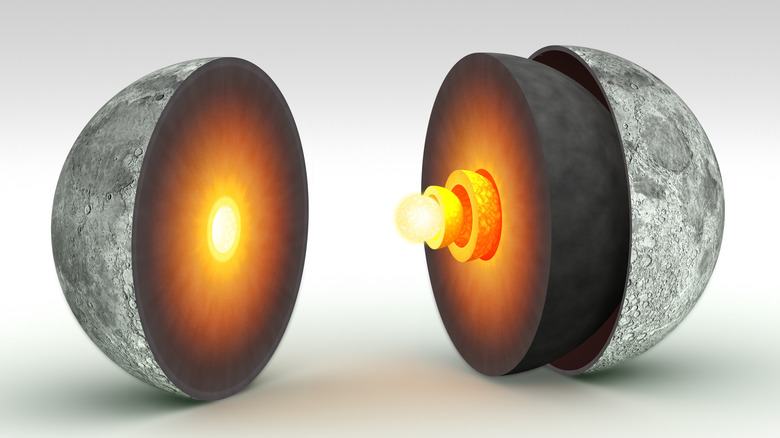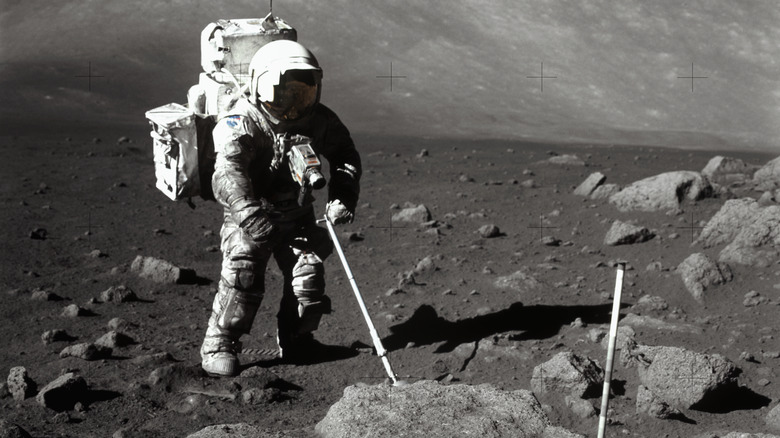Here's What We Know About The Moon's Core
The heart of the moon has long been a mystery to scientists, but recent investigations have provided insight into its composition. One study from May 2023 presents convincing evidence that the lunar core is solid, rather than liquid. Even more interesting, the study suggests that the moon's nucleus has a similar density to iron — meaning it's possibly just like the Earth's.
Understandably, it's hard to collect data about the moon's core. After all, collecting data about the Earth's core is difficult, much less our distant satellite. Indeed, the study of the Earth's core is a massive undertaking. That being said, it's a worthwhile subject of investigation, since the Earthen core serves an important purpose by generating the magnetic field that protects us from cosmic rays.
Considering the favored theory about how the Earth got its moon, similarities between the two heavenly bodies' cores can be expected. Most astrophysicists suspect the moon formed when a Mars-sized body collided with the fledgling Earth, resulting in a violent mixing of matter. According to this theory, that matter eventually coalesced into the moon we know today. As a result, the Earth and the moon share many characteristics and elements, so the idea that they also share similar cores isn't too far-fetched.
What is the moon's core made out of?
Simply based on the fact that the moon gets wailed by meteorites while the Earth's atmosphere manages to burn up most before they can make landfall, it's fair to assume that the lunar atmosphere and magnetic field are quite different from those of the Earth's. But we don't need to assume. Research shows that both the moon's atmosphere and magnetic field are nearly non-existent. As a result, the moon is susceptible to getting blasted by space debris, creating the characteristic craters on its surface. However, that doesn't mean the moon lacks an active core.
The current understanding is that the moon has a dense metal core, mostly made up of iron with trace amounts of nickel. As far as solid cores go, it's relatively small. For comparison, the Earth's core is roughly 50% of its diameter, while the moon's core is only about 20% of its diameter. Surrounding that small lunar core wraps the mantle and the crust — which are also notably stagnant.
But although the moon's core is highly likely to be solid, there's still a chance that active liquid magma churns within its mantle as well. Studies into the chemical composition of the moon suggest that it once had a violently active magmatic interior. As dense materials (like iron) were drawn into the center of the moon and lighter materials drifted towards the surface, the moon's inner layers cooled.
One study from 2011 suggests that the moon hasn't frozen solid just yet. The paper published in Science analyzed seismograms to argue that the moon's core is as much as 60% liquid by volume. However, the paper also presents evidence that the inner core is solid while the outer core is liquid.
What we don't know about the moon's core
Proposals about the moon's core are based on three main sources of data: Earth-based telescopic studies, remote sensors from unmanned lunar craft, and samples brought back to Earth by moon-walking astronauts. That latter data have proved to be the most enlightening, since they led to the discovery of anorthite clasts in the lunar surface. These molecular structures provide strong evidence that the moon went through a molten phase to allow such compounds to crystallize and form.
Clearly, much of what we know about what lays below the lunar surface is based on extrapolation. Scientists readily admit a vast deficit in our understanding of the lunar core, and every new data point can provide new insights.
Nonetheless, that's not to say we should discredit the findings of lunar studies. The majority of investigations into the moon's core point towards a solid lunar core with a magmatic mantle. And while scientists continue to debate and amend the "magma ocean model" of the moon, the general consensus paints a picture of a moon with an inner world not unlike that of our terrestrial home. Though it's weaker and smaller, the lunar core still seems to be something of a twin to the Earth's core.


